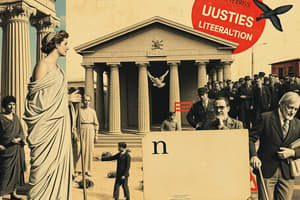Podcast
Questions and Answers
What is the 'black box' referred to in the text?
What is the 'black box' referred to in the text?
- The cognitive processes
- The brain (correct)
- The stimuli
- The environment
How are theories or models of cognitive processes tested?
How are theories or models of cognitive processes tested?
- By modifying concepts
- Empirically by doing research (correct)
- By categorizing stimuli
- By forming inferences
What do we compare stimuli to in order to categorize them?
What do we compare stimuli to in order to categorize them?
- Inferences
- Conceptual representations (correct)
- The environment
- Cognitive processes
What is the basic assumption about our ability to categorize stimuli?
What is the basic assumption about our ability to categorize stimuli?
What is stored in our LTM according to the text?
What is stored in our LTM according to the text?
What dominated our understanding of conceptual representation until the 1970s?
What dominated our understanding of conceptual representation until the 1970s?
Where do cognitive processes occur?
Where do cognitive processes occur?
How do we make inferences about cognitive processes?
How do we make inferences about cognitive processes?
What leads to new experiments to test theories?
What leads to new experiments to test theories?
What is presumed to be involved in categorizing stimuli?
What is presumed to be involved in categorizing stimuli?
What do we have no direct access to, according to the text?
What do we have no direct access to, according to the text?
What do we modify, leading to new experiments to test theories?
What do we modify, leading to new experiments to test theories?
According to the classical view of categories, how are categories defined?
According to the classical view of categories, how are categories defined?
How is family resemblance defined?
How is family resemblance defined?
What does the classical view consider concepts to be mentally represented as?
What does the classical view consider concepts to be mentally represented as?
How do participants rate category membership according to the text?
How do participants rate category membership according to the text?
What influences category membership decisions and categorization decision times?
What influences category membership decisions and categorization decision times?
According to the text, what is the concept of family resemblance correlated with?
According to the text, what is the concept of family resemblance correlated with?
How are category boundaries described in the concept of family resemblance?
How are category boundaries described in the concept of family resemblance?
What do the features generated by participants tend to apply to, according to the text?
What do the features generated by participants tend to apply to, according to the text?
According to the text, how do category membership decisions and categorization decision times get influenced?
According to the text, how do category membership decisions and categorization decision times get influenced?
What is the alternative approach to the classical view of categories according to the text?
What is the alternative approach to the classical view of categories according to the text?
How are categories defined according to the classical view?
How are categories defined according to the classical view?
What is the main claim of the classical view of categories according to the text?
What is the main claim of the classical view of categories according to the text?
Flashcards are hidden until you start studying
Study Notes
Classical View of Categories and Family Resemblance
- Classical view of categories is based on the premise that categories are defined by the presence or absence of specific properties.
- Categories are defined by necessary and sufficient features, with no in-between cases and all members being equal.
- The main claims of the classical view are that concepts are mentally represented as definitions, providing characteristics necessary and sufficient for category membership.
- Membership of categories such as squares and even numbers is defined by specific properties, which are necessary and sufficient for classification.
- Category membership isn't binary, as demonstrated by participants rating membership on a continuum from 0 to 100% and changing their inclusion criteria over time.
- Some category members are considered more typical or representative than others, as shown by high inter-rater reliability in typicality ratings.
- Category membership decisions and categorization decision times are influenced by typicality, with typical members being confirmed or generated more frequently.
- Even classically definable categories show typicality effects, with certain members being more typical than others.
- An alternative approach to the classical view is the concept of family resemblance, where categories are defined by overlapping distributions of features.
- Family resemblance is a weighted sum of featural overlap among category members, with a strong correlation between typicality and family resemblance.
- Category boundaries are fuzzy and category membership doesn't imply equality, with some members being more typical or 'better' category members than others.
- The features generated by participants tend to apply to a small subset of category members, and none of the features are necessary and sufficient.
Studying That Suits You
Use AI to generate personalized quizzes and flashcards to suit your learning preferences.





